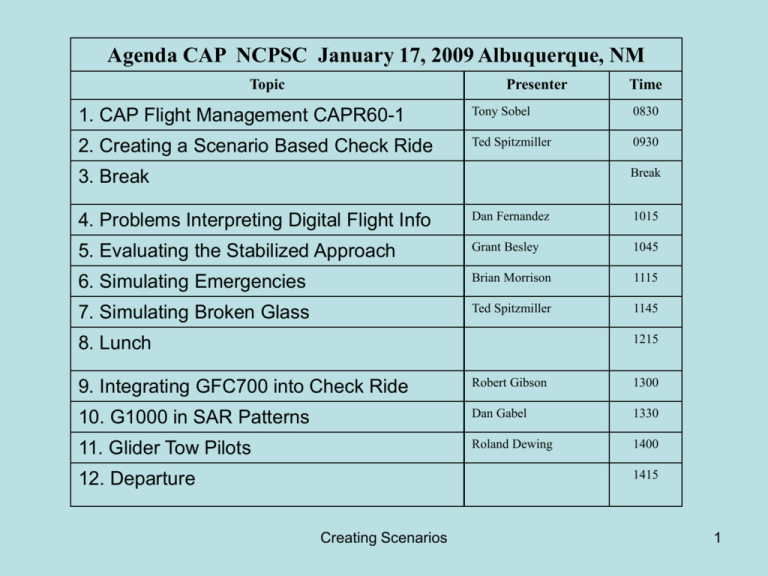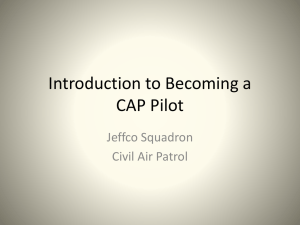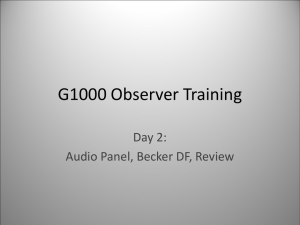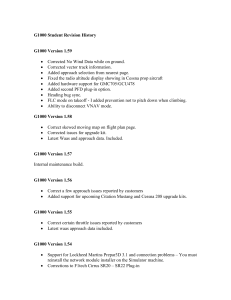Creating-Scenarios
advertisement

Agenda CAP NCPSC January 17, 2009 Albuquerque, NM Topic Presenter Time 1. CAP Flight Management CAPR60-1 Tony Sobel 0830 2. Creating a Scenario Based Check Ride Ted Spitzmiller 0930 Break 3. Break 4. Problems Interpreting Digital Flight Info Dan Fernandez 1015 5. Evaluating the Stabilized Approach Grant Besley 1045 6. Simulating Emergencies Brian Morrison 1115 7. Simulating Broken Glass Ted Spitzmiller 1145 1215 8. Lunch 9. Integrating GFC700 into Check Ride Robert Gibson 1300 10. G1000 in SAR Patterns Dan Gabel 1330 11. Glider Tow Pilots Roland Dewing 1400 1415 12. Departure Creating Scenarios 1 Creating Flight Training Scenarios http://www.faa.gov/education_research/training/fits/guidance / Ted Spitzmiller NM Wing thspitzmiller@msn.com Creating Scenarios 2 Objectives • • • • • Review 60-1 Requirements Characterize FITS Define Scenario Based Training Evaluate Tasks Create a Scenario Creating Scenarios 3 OLD CAPR 60-1 3-3. Pilot Aircraft Qualification Requirements. •(7) For C182 NAV III (G1000): (a) CAP factory-trained instructors must check out other CAP instructor pilots before those instructors can teach in G1000 equipped aircraft. •CAP factory-trained instructors will use the full Cessna instructor training syllabus when checking out other CAP instructor pilots. •CAP instructors will use the full Cessna FITS transition syllabus and all provided training materials when conducting ground and flight training for CAP pilots. Creating Scenarios 4 NEW 60-1 3-6 a.(4)(a) • Complete the CAP Cessna G1000 transition syllabus for VFR operation. This is FITS Instructor Syllabus NAV III Cessna SEP Scenario Based Instructor Guide Creating Scenarios 5 Therefore… Check Pilots and Instructors must be familiar with… Creating Scenarios 6 FITS Requirements • Cessna SEP FITS Syllabus – – – – – – Guide to safely transition pilots to TAA aircraft. List of specific tasks to be accomplished. Provides realistic replication of real world, day-to-day flying. Emphasis on planning and execution with minimal instruction. Stress Aeronautical Decision Making Assess Risk Mgt • The value—opportunities to plan, execute, and respond to changing situations in a thoughtful way. Creating Scenarios 7 OLD G1000 PIC Ops — 60-1 • Prior to operating CAP G1000 aircraft as PIC, – each CAP pilot must receive an initial CAPF 5 from • a factory-trained or • CAP designated check pilot who meets all requirements as a FITS qualified flight instructor – IAW the Cessna training syllabus – Non-factory trained check pilots… must have provided a minimum of 15 hours of logbookdocumented aircraft instruction in G1000 equipped aircraft prior to being eligible for designation by wing/region commander as a G1000 check pilot. Creating Scenarios 8 New 60-1 • For flight instructor privileges in G1000, complete the CAP Cessna G1000 transition syllabus for Flight Instructors that is given by a Cessna factory trained instructor. • OK, so what is this new SBT all about… Creating Scenarios 9 Desired Pilot in Training (PT) Scenario Outcomes • Success is measured in the following desired outcomes: – Describe - physical characteristics and cognitive elements of scenario activities. – Explain - scenario activity and understand underlying concepts, principles, and procedures that comprise the activity. – Practice - scenario activity with little input from CFI. – Perform - activity without assistance from the CFI. • At no time will successful completion of activity be in doubt. • Signifies satisfactory proficiency in piloting and systems operation skills. – Manage / Decide - identify possible courses of action, evaluate risk inherent in each, and make appropriate decision. • Signifies satisfactory SRM skills. Creating Scenarios 10 Scenario-Based transition flight Training (SBT) • Traditional approach: – – – – analyze a maneuver break it into manageable sizes establish behavioral objectives measure performance based on the objectives. • SBT uses same maneuvers but arranges into “real world” learning experiences. – Practice remains cornerstone of skill acquisition; – SBT challenges the pilot to think and be proactive • Reconciling PTS and Form 5 Creating Scenarios 11 Cessna Recommendations — Deleted… No turbos in NM Scenario #4 Night Operations — Added Creating Scenarios 12 Cessna Scenario VFR Leg 1 • The flight plan for Lawrence, KS. training operations will be from Lawrence to Emporia. KEMP has excellent facilities, weather reports, and forecasts available. Runway length is 5000’ with lights, Unicom, service along with 2 GPS and 2 VOR approaches. The distance is about 62 N.M. and should take about 30 minutes at 4500’. There are good pilotage land marks for correlation with the sectional chart, GPS and moving map of the MFD. The emphasis for this flight will be placed on cockpit displays, use of automation and to acquire a general feel of the airplane. Creating Scenarios 13 Actions and Tasks • The PT will perform a normal takeoff and departure to a safe altitude using the manufacturers approved checklist and appropriate climb speeds. When a stabilized climb has been established, the autopilot will be engaged at 800 feet AGL. Collision avoidance procedures will continue to be used during the climb to a VFR cruise transition with the assistance of any equipment installed. Aircraft systems, avionics and autopilot functions will be practiced during cruise, descent and normal landing phase of the flight. The VNAV function (if equipped) will be used as well as any other form of automation that is appropriate. The VFR PT will perform a normal descent and pattern transition followed by a normal approach and landing. Continued use of any automation and MFD resources is encouraged. Creating Scenarios 14 What does it say the PT must do? • with the assistance of any equipment installed. Aircraft systems, avionics and autopilot functions will be practiced… • …use… any other form of automation that is appropriate… • Continued use of any automation and MFD resources is encouraged. • The emphasis for this flight will be placed on cockpit displays, use of automation and to acquire a general feeling of the airplane. Creating Scenarios 15 Cessna Task List • Redundancies – Make for a long list • Ambiguities – What G1000 features are important? • Wasted space Creating Scenarios 16 Creating Scenarios 17 Create scenario based task list Creating Scenarios 18 Scenario Decision Tree Fuel. WX, PAX, Schedule A/C Equip Failure AHRS, ADC, GPS Alternator Preflight Discussion Gnd Based Failure NavAid, Lighting Comm Failure Wx Hazard TStorms, Icing Low Ceiling/Vis Get Data Sample Options Divert Notify ATC, Troubleshoot Change Freq. Shed Electrical Load Switch tanks Carb Heat, Cowl Flaps Change Altitude pitot heat Analyze Decision Consequence Y Consequence X Post flight Scenarios Critique Creating 19 OLD G1000 Caveats • (b) Pilots are required to practice “round dial” emergency maneuvers on G1000 aircraft check rides (Broken Glass). • (c) CAP pilots who wish to exercise instrument privileges must receive a CAPF 5 flight evaluation requiring a demonstration of pilot proficiency in all G1000 instrument capabilities. • (d) CAP instrument rated pilots who are current to fly both G1000 equipped aircraft and conventional “round dial” aircraft must accomplish – half of the approaches for FAA instrument currency in glass cockpit aircraft and – half in “round dial” aircraft. Creating Scenarios 20 New 60-1 • For instrument operating privileges in G1000, complete the CAP Cessna G1000 transition syllabus for Instrument operation. • To remain current for instrument privileges in G1000 airplanes, – a pilot must take an Instrument Proficiency Check using a G1000 airplane or – the pilot must complete three of the approaches required for ongoing FAA Instrument currency in a G1000 airplane. Creating Scenarios 21 Annual CAPF 5 • (e) To remain qualified in a G1000 aircraft, an annual CAPF 5 flight evaluation in a G1000 equipped aircraft is required. • The CAP pilot must receive the CAPF 5 check ride from a factory-trained check pilot or a check pilot who has provided at least 15 hours of logbook-documented aircraft instruction in the G1000 aircraft. • This check ride will meet the requirements for other aircraft in the same group as specified in table 3-1. • (f) There is no requirement to be C182 “round dial” qualified prior to qualifying in the G1000 equipped aircraft. Creating Scenarios 22 Note • There is NO equivalency for C-182T NAV III thus to remain current the pilot MUST take a Form 5 in that aircraft. Creating Scenarios 23 Check Pilot Discussion • Types of scenarios – VFR, IFR, High Alt, Night, Failure Modes • Identify critical tasks — Master task list • Reconciling C-182T requirements vs. Form 5 – Integration of F5 Questionnaire – Must be changed every year! • Proficiency levels… PTS Creating Scenarios 24 Be Careful Out There Creating Scenarios 25







